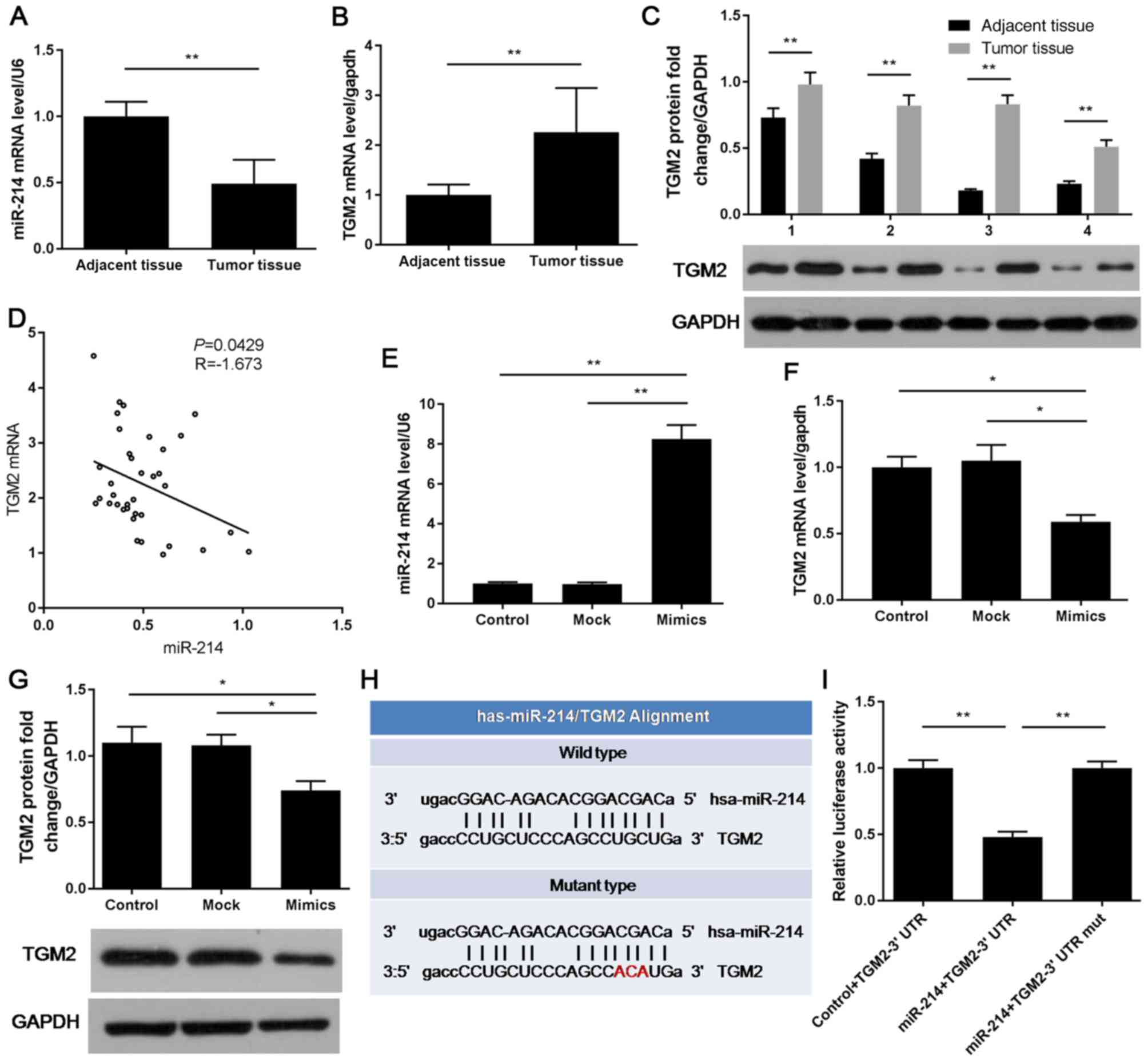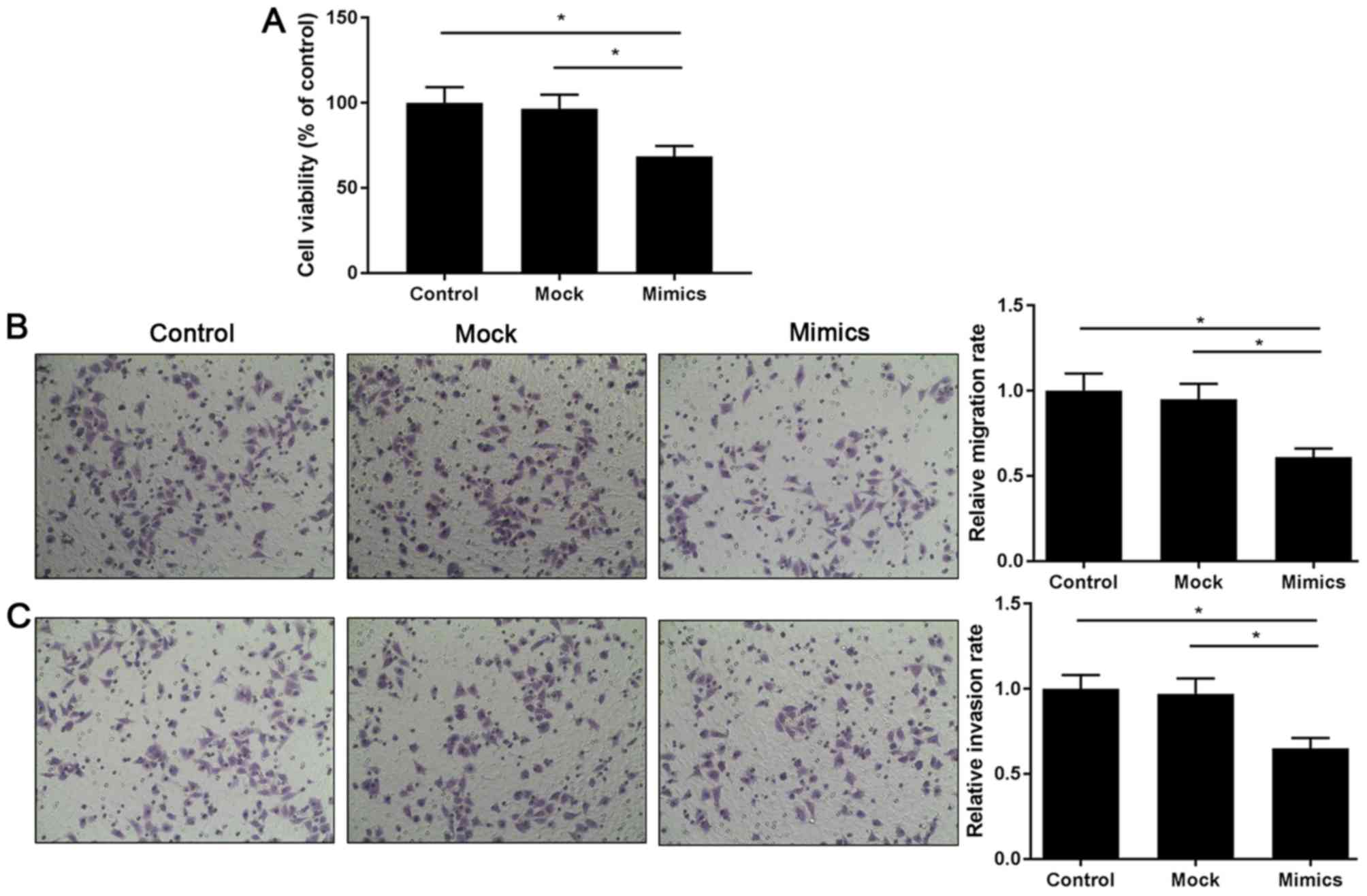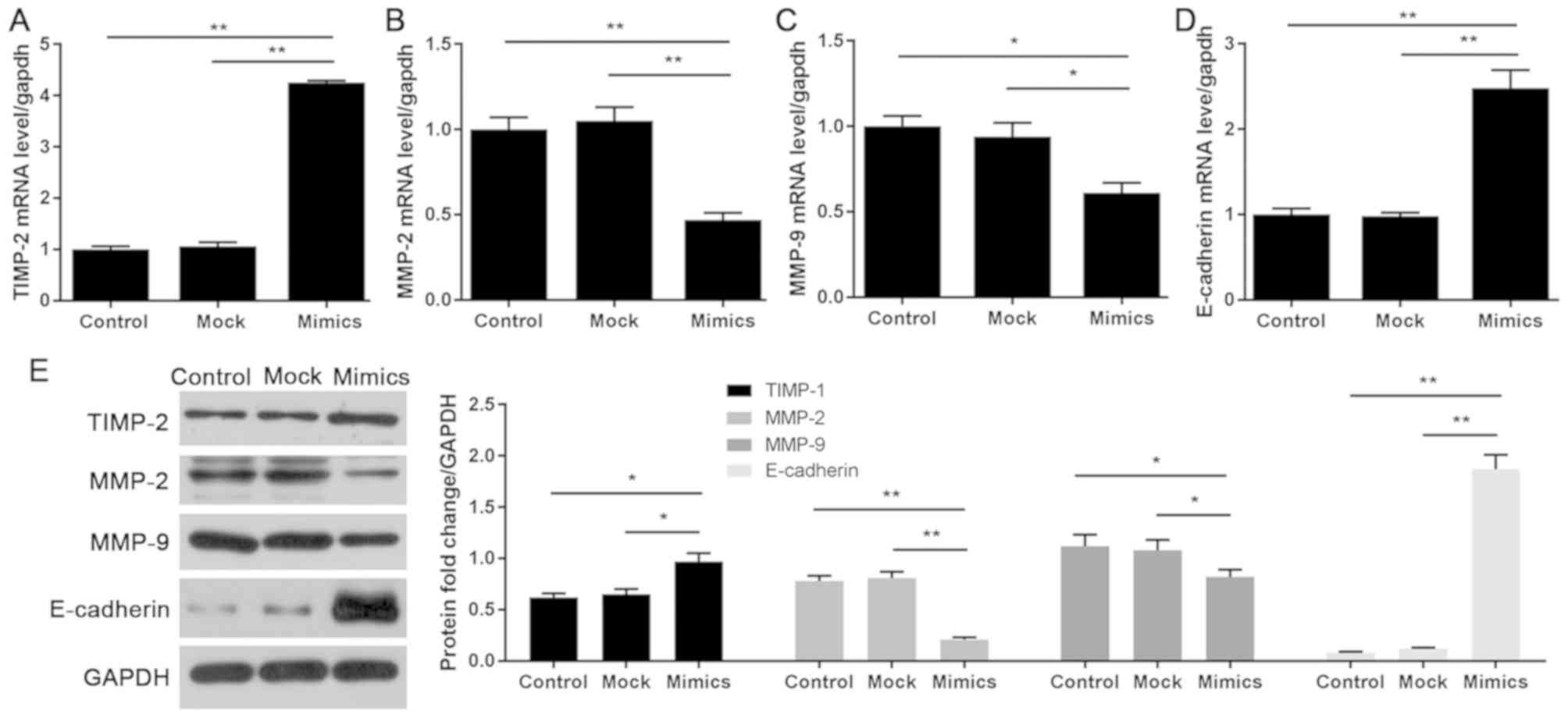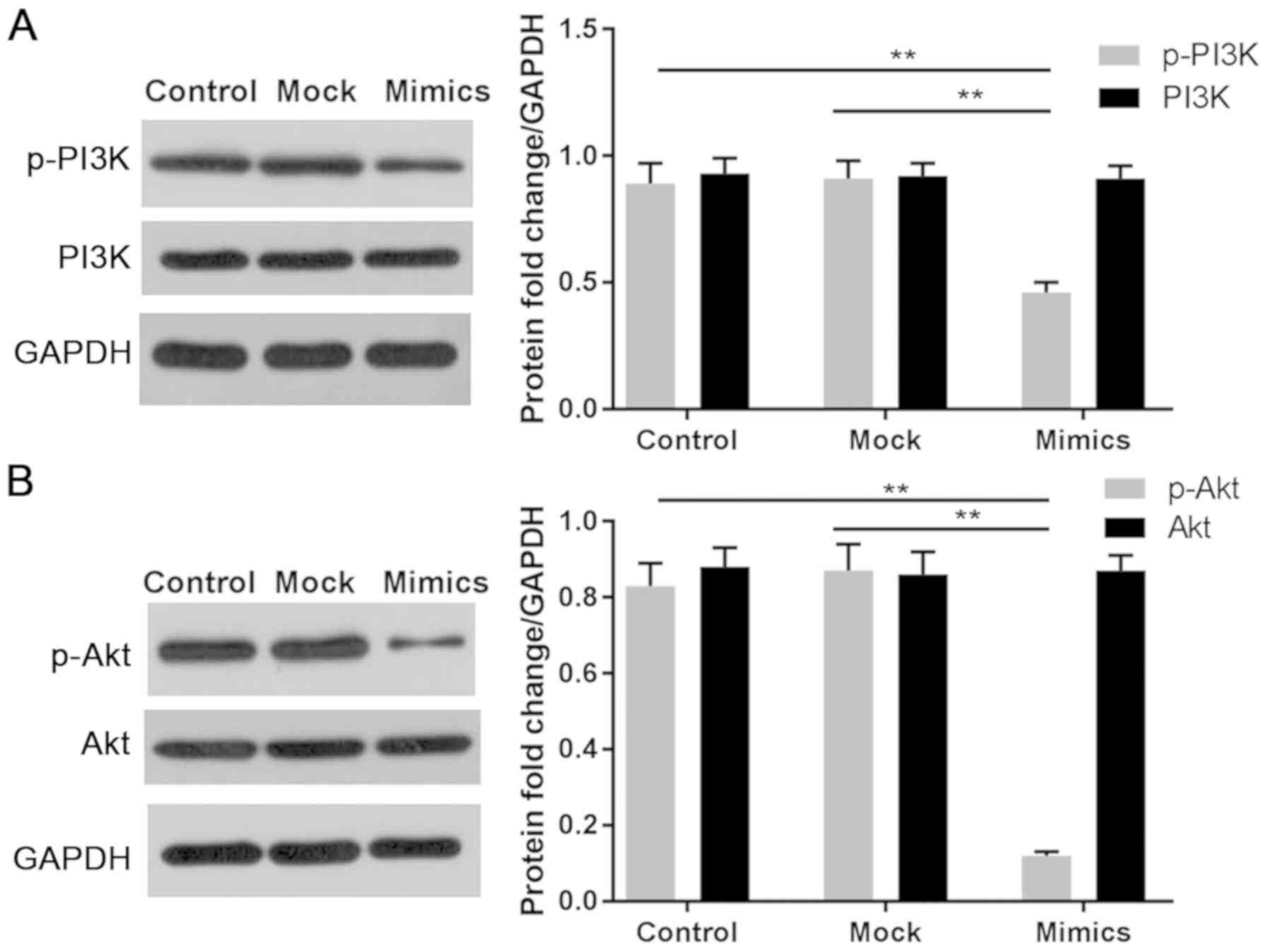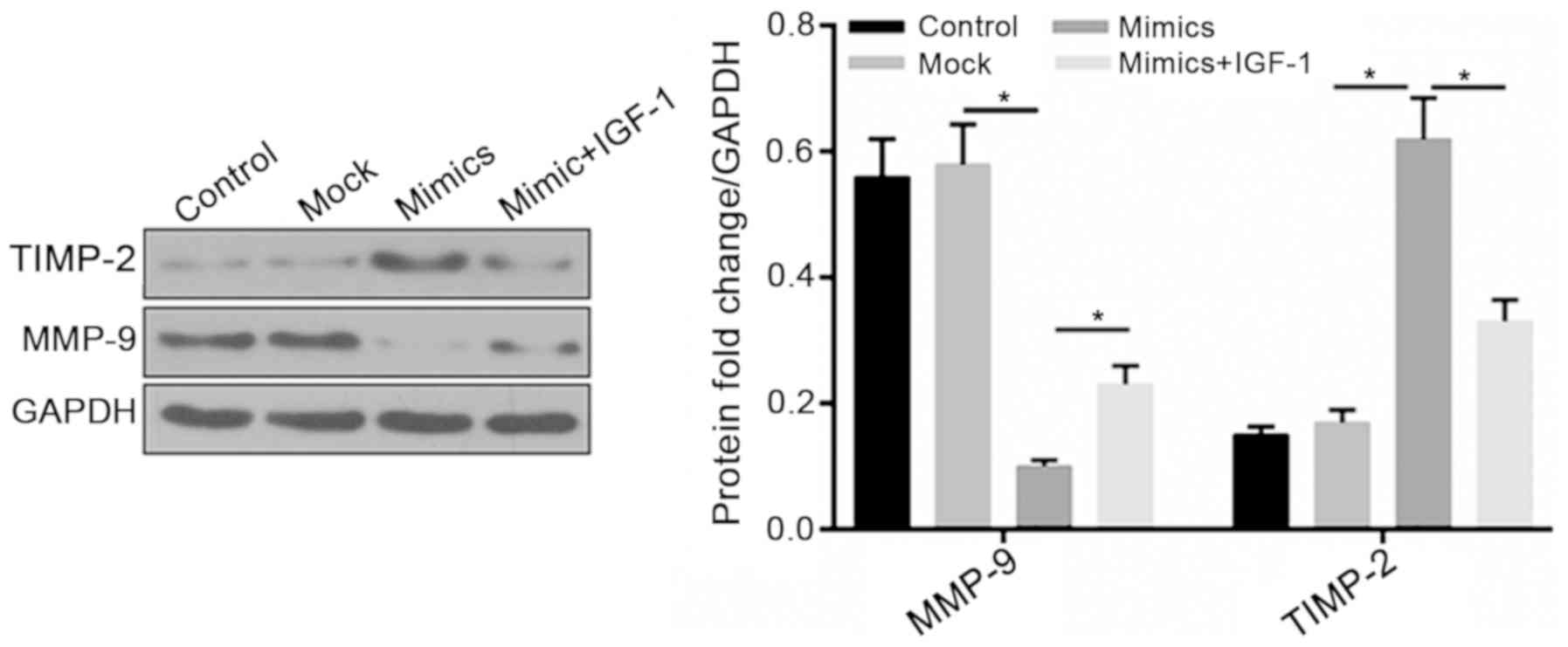|
1
|
Peng BJ, Cao CY, Li W, Zhou YJ, Zhang Y,
Nie YQ, Cao YW and Li YY: Diagnostic performance of intestinal
fusobacterium nucleatum in colorectal cancer: A meta-analysis. Chin
Med J (Engl). 131:1349–1356. 2018. View Article : Google Scholar : PubMed/NCBI
|
|
2
|
Parkin DM, Bray F, Ferlay J and Pisani P:
Global cancer statistics, 2002. CA Cancer J Clini. 55:74–108. 2005.
View Article : Google Scholar
|
|
3
|
Liao Y, Li S, Chen C, He X, Lin F, Wang J,
Yang Z and Lan P: Screening for colorectal cancer in Tianhe,
Guangzhou: Results of combining fecal immunochemical tests and risk
factors for selecting patients requiring colonoscopy. Gastroenterol
Rep (Oxf). 6:132–136. 2018. View Article : Google Scholar : PubMed/NCBI
|
|
4
|
Sun J, Hu J, Wang G, Yang Z, Zhao C, Zhang
X and Wang J: LncRNA TUG1 promoted KIAA1199 expression via miR-600
to accelerate cell metastasis and epithelial-mesenchymal transition
in colorectal cancer. J Exp Clini Cancer Res. 37:1062018.
View Article : Google Scholar
|
|
5
|
Wang H, Yao L, Gong Y and Zhang B: TRIM31
regulates chronic inflammation via NF-κB signal pathway to promote
invasion and metastasis in colorectal cancer. Am J Transl Res.
10:1247–1259. 2018.PubMed/NCBI
|
|
6
|
Wang JL, Guo CR, Su WY, Chen YX, Xu J and
Fang JY: CD24 overexpression related to lymph node invasion and
poor prognosis of colorectal cancer. Clin Lab. 64:497–505. 2018.
View Article : Google Scholar : PubMed/NCBI
|
|
7
|
Hua Q, Mi B and Huang G: The emerging
co-regulatory role of long noncoding RNAs in epithelial-mesenchymal
transition and the Warburg effect in aggressive tumors. Crit Rev
Oncol Hematol. 126:112–120. 2018. View Article : Google Scholar : PubMed/NCBI
|
|
8
|
Lamouille S, Xu J and Derynck R: Molecular
mechanisms of epithelial-mesenchymal transition. Nat Rev Mol Cell
Biol. 15:178–196. 2014. View
Article : Google Scholar : PubMed/NCBI
|
|
9
|
Cai Z, Cao Y, Luo Y, Hu H and Ling H:
Signalling mechanism(s) of epithelial-mesenchymal transition and
cancer stem cells in tumour therapeutic resistance. Clin Chim Acta.
483:156–163. 2018. View Article : Google Scholar : PubMed/NCBI
|
|
10
|
Maeda S and Nakagawa H: Roles of
E-cadherin in Hepatocarcinogenesis. Innovative Medicine: Basic
research and development. Nakao K, Minato N and Uemoto S: Springer;
Tokyo: pp. 71–77. 2015, View Article : Google Scholar
|
|
11
|
Chi Y, Huang Q, Lin Y, Ye G, Zhu H and
Dong S: Epithelial-mesenchymal transition effect of fine
particulate matter from the Yangtze River Delta region in China on
human bronchial epithelial cells. J Environ Sci (China).
66:155–164. 2018. View Article : Google Scholar : PubMed/NCBI
|
|
12
|
He J, Tang F, Liu L, Chen L, Li J, Ou D,
Zhang L, Li Z, Feng D, Li W and Sun LQ: Positive regulation of TAZ
expression by EBV-LMP1 contributes to cell proliferation and
epithelial-mesenchymal transition in nasopharyngeal carcinoma.
Oncotarget. 8:52333–52344. 2016.PubMed/NCBI
|
|
13
|
Zhou WJ, Chen J, Feng Y, Fan YP, Li Q, Fu
J and Zhang P: Inhibition of cigarettes smoke-induced epithelial to
mesenchymal transition by the SMO inhibitor PF-5274857 in Beas-2b
epithelial cells. Sichuan Da Xue Xue Bao Yi Xue Ban. 47:485–490.
2016.(In Chinese). PubMed/NCBI
|
|
14
|
Haider MT and Taipaleenmäki H: Targeting
the metastatic bone microenvironment by MicroRNAs. Front Endocrinol
(Lausanne). 9:2022018. View Article : Google Scholar : PubMed/NCBI
|
|
15
|
Amarilyo G, Pillar N, Ben-Zvi I,
Weissglas-Volkov D, Zalcman J, Harel L, Livneh A and Shomron N:
Analysis of microRNAs in familial mediterranean fever. PLoS One.
13:e01978292018. View Article : Google Scholar : PubMed/NCBI
|
|
16
|
De Los Reyes-Garcia AM, Arroyo AB,
Teruel-Montoya R, Vicente V, Lozano ML, González-Conejero R and
Martinez C: MicroRNAs as potential regulators of platelet function
and bleeding diatheses. Platelets. 1–6. 2018.(Epub ahead of print).
View Article : Google Scholar : PubMed/NCBI
|
|
17
|
Li Y, Duo Y, Bi J, Zeng X, Mei L, Bao S,
He L, Shan A, Zhang Y and Yu X: Targeted delivery of anti-miR-155
by functionalized mesoporous silica nanoparticles for colorectal
cancer therapy. Int J Nanomedicine. 13:1241–1256. 2018. View Article : Google Scholar : PubMed/NCBI
|
|
18
|
Lin Y, Chen F, Shen L, Tang X, Du C, Sun
Z, Ding H, Chen J and Shen B: Biomarker microRNAs for prostate
cancer metastasis: Screened with a network vulnerability analysis
model. J Transl Med. 16:1342018. View Article : Google Scholar : PubMed/NCBI
|
|
19
|
Tu J and Zhang YS: Advance on microRNA and
prostate cancer. Zhonghua Bing Li Xue Za Zhi. 47:388–390. 2018.(In
Chinese). PubMed/NCBI
|
|
20
|
Vera O, Jimenez J, Pernia O,
Rodriguez-Antolin C, Rodriguez C, Sanchez Cabo F, Soto J, Rosas R,
Lopez-Magallon S, Esteban Rodriguez I, et al: DNA methylation of
miR-7 is a mechanism involved in platinum response through MAFG
overexpression in cancer cells. Theranostics. 7:4118–4134. 2017.
View Article : Google Scholar : PubMed/NCBI
|
|
21
|
Hong-Yuan W and Xiao-Ping C: miR-338-3p
suppresses epithelial-mesenchymal transition and metastasis in
human nonsmall cell lung cancer. Indian J Cancer. 52 (Suppl
3):E168–E171. 2015. View Article : Google Scholar : PubMed/NCBI
|
|
22
|
Li Y, An H, Pang J, Huang L, Li J and Liu
L: MicroRNA profiling identifies miR-129-5p as a regulator of EMT
in tubular epithelial cells. Int J Clin Exp Med. 8:20610–20616.
2015.PubMed/NCBI
|
|
23
|
Lili LN, Huang AD, Zhang M, Wang L,
McDonald LD, Matyunina LV, Satpathy M and McDonald JF: Time-course
analysis of microRNA-induced mesenchymal-to-epithelial transition
underscores the complexity of the underlying molecular processes.
Cancer Lett. 428:184–191. 2018. View Article : Google Scholar : PubMed/NCBI
|
|
24
|
Penna E, Orso F and Taverna D: miR-214 as
a key hub that controls cancer networks: Small player, multiple
functions. J Invest Dermatol. 135:960–969. 2015. View Article : Google Scholar : PubMed/NCBI
|
|
25
|
Alonso L, Okada H, Pasolli HA, Wakeham A,
You-Ten AI, Mak TW and Fuchs E: Sgk3 links growth factor signaling
to maintenance of progenitor cells in the hair follicle. J Cell
Biol. 170:559–570. 2005. View Article : Google Scholar : PubMed/NCBI
|
|
26
|
Livak KJ and Schmittgen TD: Analysis of
relative gene expression data using real-time quantitative PCR and
the 2(-Delta Delta C(T)) method. Methods. 25:402–408. 2001.
View Article : Google Scholar : PubMed/NCBI
|
|
27
|
Liu Y, Zhou H, Ma L, Hou Y, Pan J, Sun C,
Yang Y and Zhang J: MiR-214 suppressed ovarian cancer and
negatively regulated semaphorin 4D. Tumour Biol. 37:8239–8248.
2016. View Article : Google Scholar : PubMed/NCBI
|
|
28
|
Yang TS, Yang XH, Wang XD, Wang YL, Zhou B
and Song ZS: MiR-214 regulate gastric cancer cell proliferation,
migration and invasion by targeting PTEN. Cancer Cell Int.
13:682013. View Article : Google Scholar : PubMed/NCBI
|
|
29
|
Wang X, Chen J, Li F, Lin Y, Zhang X, Lv Z
and Jiang J: MiR-214 inhibits cell growth in hepatocellular
carcinoma through suppression of beta-catenin. Biochem Biophys Res
Commun. 428:525–531. 2012. View Article : Google Scholar : PubMed/NCBI
|
|
30
|
Penna E, Orso F, Cimino D, Tenaglia E,
Lembo A, Quaglino E, Poliseno L, Haimovic A, Osella-Abate S, De
Pitta C, et al: microRNA-214 contributes to melanoma tumour
progression through suppression of TFAP2C. EMBO J. 30:1990–2007.
2011. View Article : Google Scholar : PubMed/NCBI
|
|
31
|
Yang H, Kong W, He L, Zhao JJ, O'Donnell
JD, Wang J, Wenham RM, Coppola D, Kruk PA, Nicosia SV, et al:
MicroRNA expression profiling in human ovarian cancer: miR-214
induces cell survival and cisplatin resistance by targeting PTEN.
Cancer Res. 68:425–433. 2008. View Article : Google Scholar : PubMed/NCBI
|
|
32
|
Zhang XJ, Ye H, Zeng CW, He B, Zhang H and
Chen YQ: Dysregulation of miR-15a and miR-214 in human pancreatic
cancer. J Hematol Oncol. 3:462010. View Article : Google Scholar : PubMed/NCBI
|
|
33
|
Chandrasekaran KS, Sathyanarayanan A and
Karunagaran D: miR-214 activates TP53 but suppresses the expression
of RELA, CTNNB1, and STAT3 in human cervical and colorectal cancer
cells. Cell Biochem Funct. 35:464–471. 2017. View Article : Google Scholar : PubMed/NCBI
|
|
34
|
Huang SD, Yuan Y, Zhuang CW, Li BL, Gong
DJ, Wang SG, Zeng ZY and Cheng HZ: MicroRNA-98 and microRNA-214
post-transcriptionally regulate enhancer of zeste homolog 2 and
inhibit migration and invasion in human esophageal squamous cell
carcinoma. Mol Cancer. 11:512012. View Article : Google Scholar : PubMed/NCBI
|
|
35
|
Schwarzenbach H, Milde-Langosch K,
Steinbach B, Müller V and Pantel K: Diagnostic potential of
PTEN-targeting miR-214 in the blood of breast cancer patients.
Breast Cancer Res Treat. 134:933–941. 2012. View Article : Google Scholar : PubMed/NCBI
|
|
36
|
Shih TC, Tien YJ, Wen CJ, Yeh TS, Yu MC,
Huang CH, Lee YS, Yen TC and Hsieh SY: MicroRNA-214 downregulation
contributes to tumor angiogenesis by inducing secretion of the
hepatoma-derived growth factor in human hepatoma. J Hepatol.
57:584–591. 2012. View Article : Google Scholar : PubMed/NCBI
|
|
37
|
Yang Z, Chen S, Luan X, Li Y, Liu M, Li X,
Liu T and Tang H: MicroRNA-214 is aberrantly expressed in cervical
cancers and inhibits the growth of HeLa cells. IUBMB Life.
61:1075–1082. 2009. View
Article : Google Scholar : PubMed/NCBI
|
|
38
|
Chandrasekaran KS, Sathyanarayanan A and
Karunagaran D: MicroRNA-214 suppresses growth, migration and
invasion through a novel target, high mobility group AT-hook 1, in
human cervical and colorectal cancer cells. Br J Cancer.
115:741–751. 2016. View Article : Google Scholar : PubMed/NCBI
|
|
39
|
Lorand L and Graham RM: Transglutaminases:
Crosslinking enzymes with pleiotropic functions. Nat Rev Mol Cell
Biol. 4:140–156. 2003. View Article : Google Scholar : PubMed/NCBI
|
|
40
|
Kang S, Oh SC, Min BW and Lee DH:
Transglutaminase 2 regulates self-renewal and stem cell marker of
human colorectal cancer stem cells. Anticancer Res. 38:787–794.
2018.PubMed/NCBI
|
|
41
|
Yamaguchi H, Kuroda K, Sugitani M,
Takayama T, Hasegawa K and Esumi M: Transglutaminase 2 is
upregulated in primary hepatocellular carcinoma with early
recurrence as determined by proteomic profiles. Int J Oncol.
50:1749–1759. 2017. View Article : Google Scholar : PubMed/NCBI
|
|
42
|
Yin J, Oh YT, Kim JY, Kim SS, Choi E, Kim
TH, Hong JH, Chang N, Cho HJ, Sa JK, et al: Transglutaminase 2
Inhibition reverses mesenchymal transdifferentiation of glioma stem
cells by regulating C/EBPbeta signaling. Cancer Res. 77:4973–4984.
2017. View Article : Google Scholar : PubMed/NCBI
|
|
43
|
Zonca S, Pinton G, Wang Z, Soluri MF,
Tavian D, Griffin M, Sblattero D and Moro L: Tissue
transglutaminase (TG2) enables survival of human malignant pleural
mesothelioma cells in hypoxia. Cell Death Dis. 8:e25922017.
View Article : Google Scholar : PubMed/NCBI
|
|
44
|
Fang Q, Yao S, Luo G and Zhang X:
Identification of differentially expressed genes in human breast
cancer cells induced by 4-hydroxyltamoxifen and elucidation of
their pathophysiological relevance and mechanisms. Oncotarget.
9:2475–2501. 2018. View Article : Google Scholar : PubMed/NCBI
|
|
45
|
Miyoshi N, Ishii H, Mimori K, Tanaka F,
Hitora T, Tei M, Sekimoto M, Doki Y and Mori M: TGM2 is a novel
marker for prognosis and therapeutic target in colorectal cancer.
Ann Surg Oncol. 17:967–972. 2010. View Article : Google Scholar : PubMed/NCBI
|
|
46
|
Park KS, Kim HK, Lee JH, Choi YB, Park SY,
Yang SH, Kim SY and Hong KM: Transglutaminase 2 as a cisplatin
resistance marker in non-small cell lung cancer. J Cancer Res Clin
Oncol. 36:493–502. 2010. View Article : Google Scholar
|
|
47
|
Sodek KL, Ringuette MJ and Brown TJ:
Compact spheroid formation by ovarian cancer cells is associated
with contractile behavior and an invasive phenotype. Int J Cancer.
124:2060–2070. 2009. View Article : Google Scholar : PubMed/NCBI
|
|
48
|
Lu Q, Xu L, Li C, Yuan Y, Huang S and Chen
H: miR-214 inhibits invasion and migration via downregulating
GALNT7 in esophageal squamous cell cancer. Tumour Biol.
37:14605–14614. 2016. View Article : Google Scholar : PubMed/NCBI
|
|
49
|
Zhao X, Lu C, Chu W, Zhang Y, Zhang B,
Zeng Q, Wang R, Li Z, Lv B and Liu J: microRNA-214 governs lung
cancer growth and metastasis by targeting carboxypeptidase-D. DNA
Cell Biol. 35:715–721. 2016. View Article : Google Scholar : PubMed/NCBI
|
|
50
|
Li B, Han Q, Zhu Y, Yu Y, Wang J and Jiang
X: Down-regulation of miR-214 contributes to intrahepatic
cholangiocarcinoma metastasis by targeting Twist. FEBS J.
279:2393–2398. 2012. View Article : Google Scholar : PubMed/NCBI
|
|
51
|
Cai HK, Chen X, Tang YH and Deng YC:
MicroRNA-194 modulates epithelial-mesenchymal transition in human
colorectal cancer metastasis. OncoTargets Ther. 10:1269–1278. 2017.
View Article : Google Scholar
|
|
52
|
Yan MD, Yao CJ, Chow JM, Chang CL, Hwang
PA, Chuang SE, Whang-Peng J and Lai GM: Fucoidan elevates
MicroRNA-29b to regulate DNMT3B-MTSS1 axis and inhibit EMT in human
hepatocellular carcinoma cells. Mar Drugs. 13:6099–6116. 2015.
View Article : Google Scholar : PubMed/NCBI
|
|
53
|
Abubaker J, Bavi P, Al-Harbi S, Ibrahim M,
Siraj AK, Al-Sanea N, Abduljabbar A, Ashari LH, Alhomoud S,
Al-Dayel F, et al: Clinicopathological analysis of colorectal
cancers with PIK3CA mutations in Middle Eastern population.
Oncogene. 27:3539–3545. 2008. View Article : Google Scholar : PubMed/NCBI
|
|
54
|
Qin Y, Huo Z, Song X, Chen X, Tian X and
Wang X: mir-106a regulates cell proliferation and apoptosis of
colon cancer cells through targeting the PTEN/PI3K/AKT signaling
pathway. Oncol Lett. 15:3197–3201. 2018.PubMed/NCBI
|
|
55
|
Song Y, Zhao Y, Ding X and Wang X:
microRNA-532 suppresses the PI3K/Akt signaling pathway to inhibit
colorectal cancer progression by directly targeting IGF-1R. Am J
Cancer Res. 8:435–449. 2018.PubMed/NCBI
|
|
56
|
Wallin JJ, Guan J, Prior WW, Lee LB, Berry
L, Belmont LD, Koeppen H, Belvin M, Friedman LS and Sampath D:
GDC-0941, a novel class I selective PI3K inhibitor, enhances the
efficacy of docetaxel in human breast cancer models by increasing
cell death in vitro and in vivo. Clin Cancer Res. 18:3901–3911.
2012. View Article : Google Scholar : PubMed/NCBI
|
|
57
|
Jia L, Luo S, Ren X, Li Y, Hu J, Liu B,
Zhao L, Shan Y and Zhou H: miR-182 and miR-135b mediate the
tumorigenesis and invasiveness of colorectal cancer cells via
targeting ST6GALNAC2 and PI3K/AKT pathway. Dig Dis Sc.
62:3447–3459. 2017. View Article : Google Scholar
|















